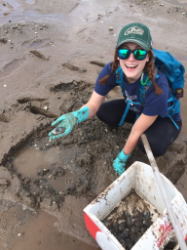Emily Blackwood
Address: Carnegie Hall, University of Maine, Orono, ME 04469
Bio:
My academic interests include humans and how they interacted with past environments and what we can learn from their behavior from an archaeological perspective. I have my B.A. in Anthropology from UMaine and choose to continue my residency here for my Master’s thesis. This research is focused on determining the seasonality of three shell midden sites located along the coast of Maine using oxygen isotopes derived from modern and archaeological shell samples. My assistantship is through Dr. Nicholas Giudice, Director of the Virtual Environment and Multimodal Interactions (VEMI) Lab, where we use virtual and augmented reality technologies as tools in our research.
Research Area:
There are over 2,000 documented shell middens along the coast of Maine, many of which are actively eroding. Maine’s shell middens represent areas that were utilized in the past by Maine’s indigenous peoples and act to preserve the organic materials (fabric, bone, wood) that otherwise would not have survived due to the acidity of our soil by neutralizing it with calcium carbonate. Oxygen isotopes within a shell reflect the environment they lived in and by comparing the ratio of O18 to O16 within a shell, the season during which the shell was harvested can be approximately determined. This ratio varies throughout the year because it is dependent on temperature and salinity, both of which fluctuate off the coast of Maine during the summer and winter. In order to have an accurate representation of oxygen isotope values throughout the year, a modern sample was collected once a month for 12 months from the mudflats surrounding the sites used in this research. These modern values are used to compare the archaeological samples against in order to determine when they were harvested and in turn assess when the sites were in use (seasonally or year-round). It is important to determine when an archaeological site was in use in order to understand its context.


